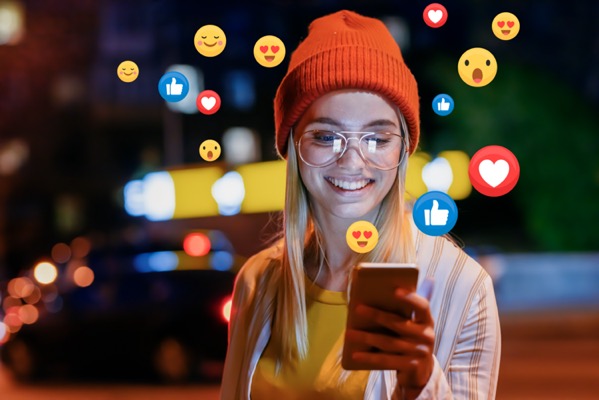Who is an influencer?
October 17 2022

Ten artykuł przeczytasz w: 7 minut
An influencer is a person who makes an impact, influencing the opinions, purchasing decisions and brand loyalty of others. An influencer is an idol, a role model, whose opinion is valued by a group of devoted fans, be it viewers, readers or listeners. Commercial cooperation with influencers is the object of influencer marketing.
If you’re asking yourself who an influencer is, the simplest definition is he/she’s just that – an influencer, running his/her own YouTube channel, a podcast, or writing for a hugely popular blog. The definition is not limited to any particular industry. This means that influencers come in all shapes and sizes and can be useful to any company. So, we have fashion influencers, automotive influencers, sports influencers, food influencers, video influencers and so on.
What does ‘influencer’ mean? Definition and differences
There are two main types of influencers – classic influencers and so-called micro-influencers. The former have enormous reach. They have social media accounts with hundreds of thousands of followers and millions of video views. The latter usually have a few or several thousand followers.
This does not make them less important. Their reach is simply more precise. Such influencers are great for niche brands and those that do not have the budgets for classic influencers. In the first case, investment expenses on promotion can come to tens or hundreds of thousands of dollars. Instead, cooperation with a micro-influencer can be priced in hundreds of dollars.
There is another term, trendsetter, which is often confused with influencer. While a trendsetter is associated with a celebrity who monetises his/her popularity through brand collaboration, an influencer is an ordinary person who influences the purchasing decisions of others like themselves. An influencer has generated popularity through online activity. He/she does not set new trends but spreads and promotes existing ones. This usually happens in the social media: blogs, Instagram, Facebook, Twitter, YouTube, TikTok.
There is another important difference – the ability to create content. Trendsetters usually hire marketing agencies to do this. Influencers, on the other hand, create and edit videos, write texts, take photos, etc. themselves. Who is an influencer? It is a creative person!
The industries in which influencers feature prominently include the fashion and beauty sector, sports, travel, film, gaming (video games), culinary and parenting.
Generally speaking, if we forget the influencer/trendsetter division, there are three types of influential people based on the criterion of reach.
Nanoinfluencer – up to 1,000 fans. Such content creators are passionate beginners who have no experience of working with brands. However, they have already built up a base of people who see their potential and trust what they say.
Microinfluencers – between 1,000 and 100,000 fans. These are semi-professionals. They refining their skill set and generally have better audio-visual equipment. It is not uncommon for them to invest in more expensive cameras, lighting and a drone to record from the air. They have a wide following. Brands often work with multiple micro-influencers at the same time. It’s all about greater reach with meaningful conversions at the same time.
Influencers – from 100,000 to 1 million fans. These are the true moguls of the Internet. They devote themselves entirely to their activities and have no other occupation. They treat their online activity as a regular profession. They also have the comfort of choosing the companies they work with. Their level of stability is defined by their activities with a narrow and permanent group of companies, with occasional cooperation with smaller entities.
No matter what kind of reach influencers have, it is important to remember one thing: in every case, they are so-called key opinion leaders (KOLs).
What is influencer marketing?
Influencer marketing is commercial collaboration with an influencer to build brand awareness among potential consumers and generate sales. It is a very effective way to create a brand from scratch or boost its market presence and promote new products.
This is also a good way to rebuild one’s image after a slip-up. However, great care is needed. Influencer marketing involves live and direct contact with the product audience and, consequently, the relationship is dynamic and very sincere. Any attempt to ‘whitewash’ can be misconstrued here. But if the brand admits its mistake and shows the changes that have taken place in the organisation, the slip-up can be forgiven. It all depends on strategy and above all – authenticity.
However, this so-called crisis PR is just a side topic. The basis of everyday cooperation with influencers is to advertise a product, service or publicise a campaign – be it sales or social. Collaboration with influencers is generally very effective, as they are highly opinion-forming individuals and, as ‘ordinary people’, enjoy a large amount of trust from their audience. Even more so because they are more authentic than trendsetters. They have not studied acting. They can make mistakes or slips of the tongue. In front of the camera and in their posts, they are authentic, or at least that is how their fans see them. It is not uncommon for them to introduce their own slang and style. They try to stand out with their personality, their creation, their style.

At all times they are authentic and do not pretend. Paid campaigns with them are effective because they use a personal style of communication with their audience to advertise products. It is as if the brands bypass the mass media with the message going straight to the target audience as if by word of mouth. An influencer stands at every corner and communicates the value of a product. In doing so, he/she shakes hands with every person they meet, and every second person is a fan of the influencer. This is more or less what it looks like.
This model of collaboration benefits everyone: benefits to the brand include higher product sales through a non-intrusive, audience-friendly advertising. Benefits to the influencer include higher earnings and market value building. Customers in their turn get an opinion on a product delivered by someone they trust instead of an annoying marketing campaign.
However, before working with an influencer, it is important to check them thoroughly. The important points are:
- influencer reach
- campaigns he/she has already carried out before (companies, format, effectiveness)
- the topics the influencer addresses in their channels
- content and format
- form of expression (serious, derisive, etc.)
This is all extremely important, as the influencer creates customised content. They and their audiences have a lot in common, such as age and gender, and last not least hobbies. These are a key factor. We will not entrust the promotion of a laid-back lifestyle brand to a blogger who dissects everything and explains the world in a complex, scientific manner. This simply won’t do.
How do you work with influencers?
Sometimes companies adopt a ‘pay and demand’ approach. They try to impose a way of campaigning, means of expression, specific actions. This is a big mistake. Let’s remember that it is the influencer who is the creative person here, and his/her power is both causal and authentic, as well as spontaneous. The influencer will frown upon any attempt to interfere with the look and form of the campaign.
It is much better to define a framework for collaboration. What does the brand want to achieve and what does it want to avoid? In order for the cooperation to work, you need to know the audience of the influencer and to give him/her the freedom to fit the concept of promotional activities into his/her individual style of communication with fans. In this way, the advertising will be more natural and effective. You need to agree on a creative concept, but give the initiative to the opinion leaders themselves.
How do you measure the effectiveness of campaigns with influencers?
Who is an influencer? The holder of a certain amount of social capital. An opinion leader’s recommendation of a product is strongly linked to two issues – authority and social proof. I like the person, I respect the person. He/she is an authority for me, a role model. So I buy the product he/she advertises. He/she is trusted by a larger number of people? That means I am not alone. So many people cannot be wrong. All the more so because I am part of that mass, so a self-perpetuating circle is created to confirm that this thinking is right. This is what it looks like in practice.
How do you measure the effectiveness of campaigns with influencers? Analytical tools such as Google Analytics, Sotrender, Brand24 and the like are baseline. You can test measurability, for example, by offering observers a pool of discount codes for a product. Here, there is bound to be a fear of missing out (FOMO) effect, which will make fans wary of missing out and so they will buy the product at a lower price.
There are also additional indicators. As opinion leaders engage the community, it is certainly worth checking the measurable engagement of followers. The number of comments under a piece of content, the number of likes and shares are the simplest possible metric. It is important to bear in mind that long-term collaboration brings results. A one-off “gig” in the form of an article or product placement in a video won’t necessarily translate into higher sales. This is why contracts regarding multiple materials are the key: with several people, for several weeks or months.
Who is an influencer? A creative and influential person, who is just one of many elements of an effective brand positioning and marketing strategy.
O Autorze

